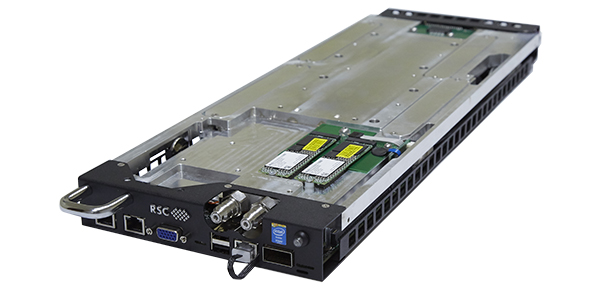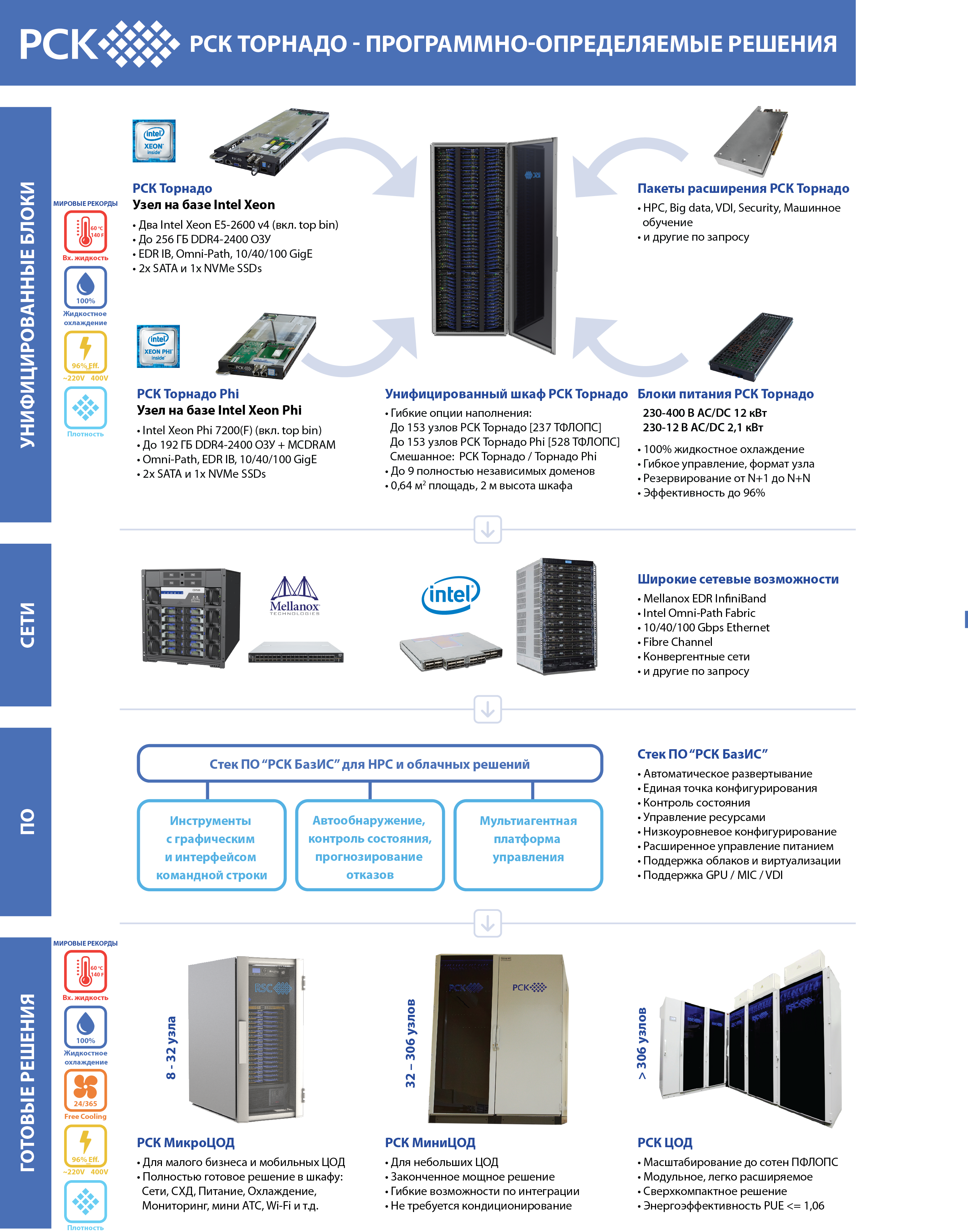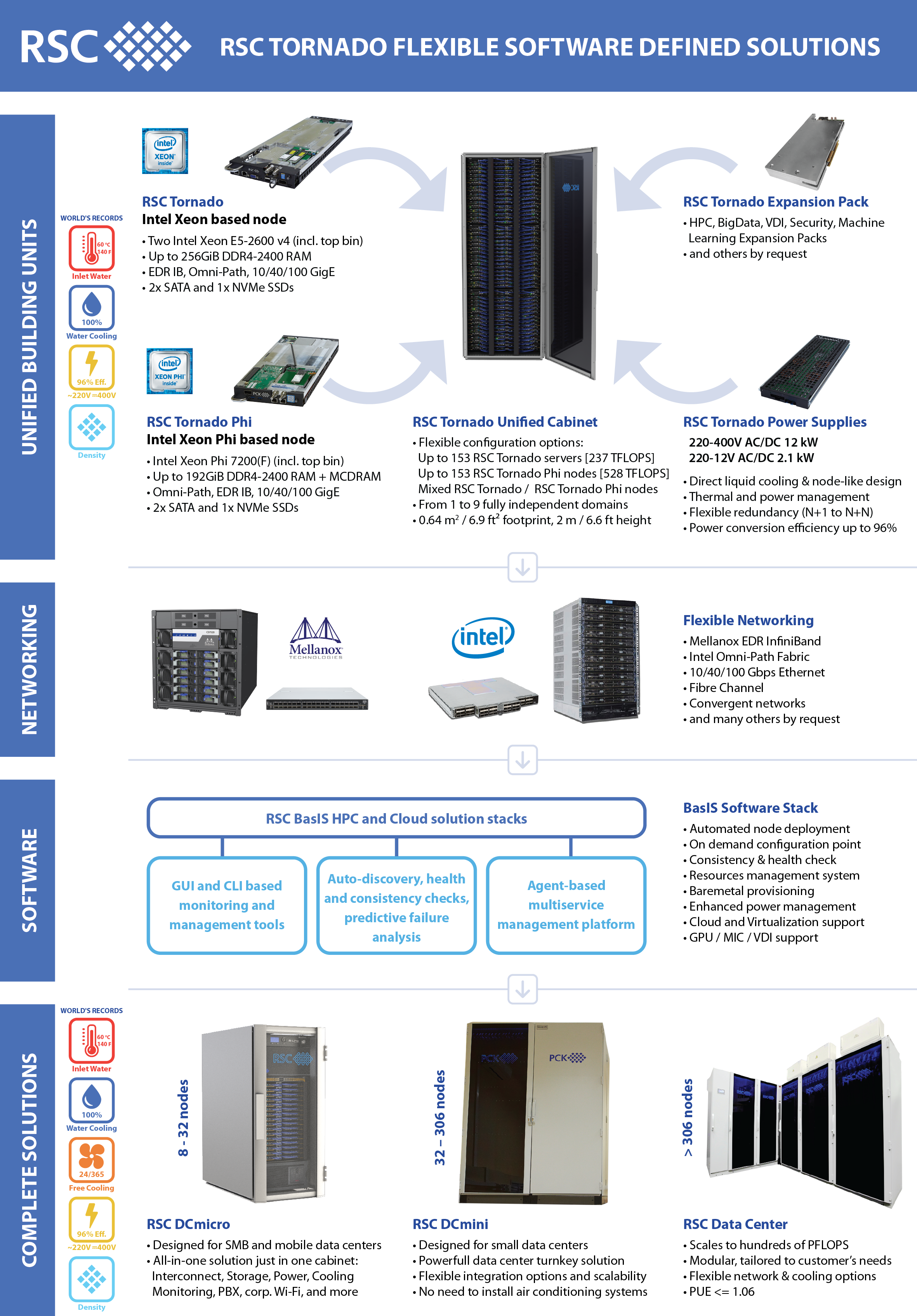 |
RSC Tornado cluster architecture
New high-density RSC Tornado cluster architecture provides unmatched energy efficiency and computing density while maintaining time-proven operating qualities.
Part number:
Supplier:
RSC Group Description
RSC TORNADO CLUSTER ARCHITECTURE
Updated high-density RSC Tornado cluster architecture provides unmatched energy efficiency and computing density while maintaining time-proven operating qualities. Now over 280 teraflops or 153 dual-processor computing nodes/servers per 42U cabinet taking only 0.64 m2 space.
Advantages
Record-breaking computing density – up to 153 dual-processor expandable х86 nodes/servers with high grade Intel® Xeon® E5-2600 v3 processors equivalent to 280.6 TFLOPS in a standard 42U cabinet (80х80х200 cm);
Record-breaking power density – up to 100 kW per 42U cabinet (800х800х200 mm) with proven high efficiency RSC liquid cooling technology providing record breaking power density and compactness;
Record-breaking energy efficiency — PUE (Power Usage Effectiveness) is less than 1.06 (i.e. system cooling consumes max. 6% of all power), which is a record for HPC industry;
Computing nodes are specifically designed for stable operation with high-temperature cooling media (up to 650С input). This provides unmatched energy efficiency and enables heat recuperation without additional heating;
Support of new high-speed node interconnect technologies including Mellanox® EDR Infiniband, Intel® Omni-Path and others;
Independent expandable base computing node/server;
A comprehensive balanced solution combining:
Highest performance models of Intel processors (from Intel® Xeon® E5-2697 / E5-2699 v3) and leading standard server boards;
Intelligent power management with backup power supply;
Intelligent management system RSC BasIS;
Redundancy;
Expandability with PCI Express Gen3 interfaces and expansion pack diversity;
Support of node hot-swap without impact on adjacent nodes;
Support of future Intel Xeon processors and Intel Xeon Phi coprocessors (Broadwell and Knights Landing architecture code names)
Easy expansion of functionality for specific tasks with a wide range of expansion packs – base node concept and various hardware and software expansion modules enable significant enhancement of system functionality without node replacement or significant modification;
RSC Tornado Expansion pack: An optional functionality expansion solution that can fully meet specific requirements of different customers. It is a fully tested package that can be used right after installation and includes all necessary expansion cards, RSC liquid cooling components, interconnection boards and mounting elements;
RSC Tornado HPC-M Expansion Pack focused on high-performance computing with up to two Intel® Xeon Phi™ coprocessors improves computing node performance to 3.74 TFLOPS;
RSC Tornado HPC-G Expansion Pack focused on high-performance computing with up to two NVIDIA® Tesla® K40 GPUs;
RSC Tornado BigData Expansion Pack provides price-performance optimized configuration for high-performance data processing;
RSC Tornado VDI Expansion Pack is intended for virtualization and remote workplace access and for CAD/CAM/CAE fields. It is based on AMD FirePro™ S10000 or NVIDIA GRID™ K1/K2 cards and on Intel® SSD DC P3700 high-performance solid-state drives;
RSC Tornado Security&Protection Expansion Pack is developed specifically for customers from financial vertical market and other users that require maximum access speed and data protection;
Hardware and software package RSC SDM Expansion Pack implements Software Defined Management concept developed by RSC specialists for RSC Tornado and RSC PetaStream computing nodes improving manageability and accessibility of computing systems for user applications. Flexible combination of management agents (infrastructure components, computing nodes, scheduler and user application libraries) within the scope of this concept enables creation of new Task-Oriented Management Applications (TOMA) that improve computing system efficiency and reduce operating costs. One of the examples of this is an application for adaptive management of task scheduler priorities that considers available power resources and actual capacity of data center cooling systems to prevent task termination and resulting loss of critical data on temporary infrastructure failures;
Other specialized expansion packs can also be created on specific requests of the customers. This approach has significantly improved availability of specialized configurations and made modernization process much more easy while preserving record compactness, computing density and power density of solutions based on RSC Tornado cluster architecture.
Universal chassis cabinet with record-breaking RSC liquid cooling system (up to 100 kW per cabinet) balanced for high temperature cooling media (up to 650C at computing node input);
The chassis cabinet contains all necessary elements for work such as: carrier chassis, cooling media distribution system, power supply system for computing nodes. Maintenance work can be performed only at one side of the cabinet.
Modular cooling and power supply system, enhanced redundancy.
Independent hydraulic pump modules of the liquid cooling system enable flexible configurations with redundancy from N+1 to N+N.
Power supply modules in computing node form factor supporting common bus enable power redundancy from N+1 to N+N.
Cabinet design supports replacement of hydraulic regulation modules in hot swap mode without interruption of computing system operation.
Cost reduction Broadly available components (server boards, memory modules) and excellent computing efficiency (96% score of LINPACK test) provide significant cost reduction.
With RSC liquid cooling system there is no need to install expensive precision air conditioning systems at server rooms. Modular cooling and power supply system enables fast and efficient capacity expansion on demand.
High reliability High availability and fail-safe operation are provided by an innovative system of control and monitoring of separate nodes and the entire cluster system, expanded power management, absence of moving parts (such as fans or traditional hard disks), redundancy of power supplies and hydraulic regulation modules. All elements of the system have a dedicated controller providing a broad range of measurement and management features.
Updated high-density RSC Tornado cluster architecture provides unmatched energy efficiency and computing density while maintaining time-proven operating qualities. Now over 280 teraflops or 153 dual-processor computing nodes/servers per 42U cabinet taking only 0.64 m2 space.
Advantages
Record-breaking computing density – up to 153 dual-processor expandable х86 nodes/servers with high grade Intel® Xeon® E5-2600 v3 processors equivalent to 280.6 TFLOPS in a standard 42U cabinet (80х80х200 cm);
Record-breaking power density – up to 100 kW per 42U cabinet (800х800х200 mm) with proven high efficiency RSC liquid cooling technology providing record breaking power density and compactness;
Record-breaking energy efficiency — PUE (Power Usage Effectiveness) is less than 1.06 (i.e. system cooling consumes max. 6% of all power), which is a record for HPC industry;
Computing nodes are specifically designed for stable operation with high-temperature cooling media (up to 650С input). This provides unmatched energy efficiency and enables heat recuperation without additional heating;
Support of new high-speed node interconnect technologies including Mellanox® EDR Infiniband, Intel® Omni-Path and others;
Independent expandable base computing node/server;
A comprehensive balanced solution combining:
Highest performance models of Intel processors (from Intel® Xeon® E5-2697 / E5-2699 v3) and leading standard server boards;
Intelligent power management with backup power supply;
Intelligent management system RSC BasIS;
Redundancy;
Expandability with PCI Express Gen3 interfaces and expansion pack diversity;
Support of node hot-swap without impact on adjacent nodes;
Support of future Intel Xeon processors and Intel Xeon Phi coprocessors (Broadwell and Knights Landing architecture code names)
Easy expansion of functionality for specific tasks with a wide range of expansion packs – base node concept and various hardware and software expansion modules enable significant enhancement of system functionality without node replacement or significant modification;
RSC Tornado Expansion pack: An optional functionality expansion solution that can fully meet specific requirements of different customers. It is a fully tested package that can be used right after installation and includes all necessary expansion cards, RSC liquid cooling components, interconnection boards and mounting elements;
RSC Tornado HPC-M Expansion Pack focused on high-performance computing with up to two Intel® Xeon Phi™ coprocessors improves computing node performance to 3.74 TFLOPS;
RSC Tornado HPC-G Expansion Pack focused on high-performance computing with up to two NVIDIA® Tesla® K40 GPUs;
RSC Tornado BigData Expansion Pack provides price-performance optimized configuration for high-performance data processing;
RSC Tornado VDI Expansion Pack is intended for virtualization and remote workplace access and for CAD/CAM/CAE fields. It is based on AMD FirePro™ S10000 or NVIDIA GRID™ K1/K2 cards and on Intel® SSD DC P3700 high-performance solid-state drives;
RSC Tornado Security&Protection Expansion Pack is developed specifically for customers from financial vertical market and other users that require maximum access speed and data protection;
Hardware and software package RSC SDM Expansion Pack implements Software Defined Management concept developed by RSC specialists for RSC Tornado and RSC PetaStream computing nodes improving manageability and accessibility of computing systems for user applications. Flexible combination of management agents (infrastructure components, computing nodes, scheduler and user application libraries) within the scope of this concept enables creation of new Task-Oriented Management Applications (TOMA) that improve computing system efficiency and reduce operating costs. One of the examples of this is an application for adaptive management of task scheduler priorities that considers available power resources and actual capacity of data center cooling systems to prevent task termination and resulting loss of critical data on temporary infrastructure failures;
Other specialized expansion packs can also be created on specific requests of the customers. This approach has significantly improved availability of specialized configurations and made modernization process much more easy while preserving record compactness, computing density and power density of solutions based on RSC Tornado cluster architecture.
Universal chassis cabinet with record-breaking RSC liquid cooling system (up to 100 kW per cabinet) balanced for high temperature cooling media (up to 650C at computing node input);
The chassis cabinet contains all necessary elements for work such as: carrier chassis, cooling media distribution system, power supply system for computing nodes. Maintenance work can be performed only at one side of the cabinet.
Modular cooling and power supply system, enhanced redundancy.
Independent hydraulic pump modules of the liquid cooling system enable flexible configurations with redundancy from N+1 to N+N.
Power supply modules in computing node form factor supporting common bus enable power redundancy from N+1 to N+N.
Cabinet design supports replacement of hydraulic regulation modules in hot swap mode without interruption of computing system operation.
Cost reduction Broadly available components (server boards, memory modules) and excellent computing efficiency (96% score of LINPACK test) provide significant cost reduction.
With RSC liquid cooling system there is no need to install expensive precision air conditioning systems at server rooms. Modular cooling and power supply system enables fast and efficient capacity expansion on demand.
High reliability High availability and fail-safe operation are provided by an innovative system of control and monitoring of separate nodes and the entire cluster system, expanded power management, absence of moving parts (such as fans or traditional hard disks), redundancy of power supplies and hydraulic regulation modules. All elements of the system have a dedicated controller providing a broad range of measurement and management features.

